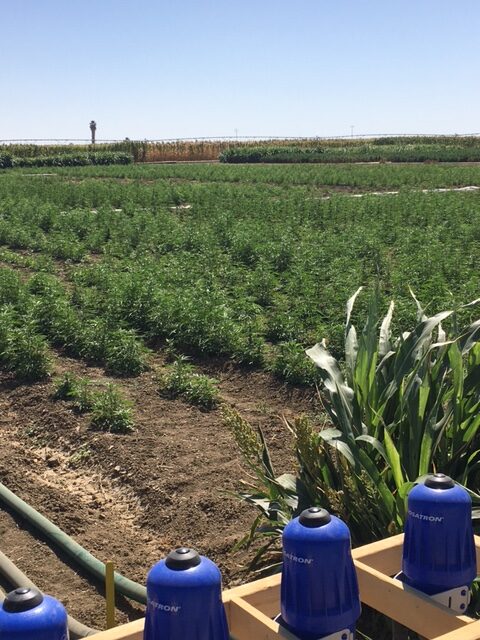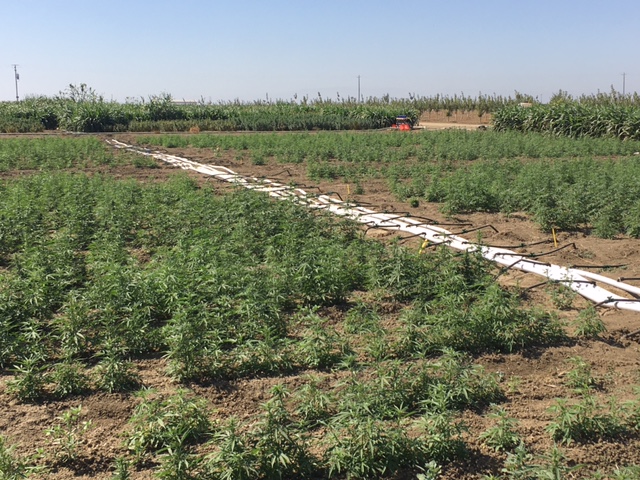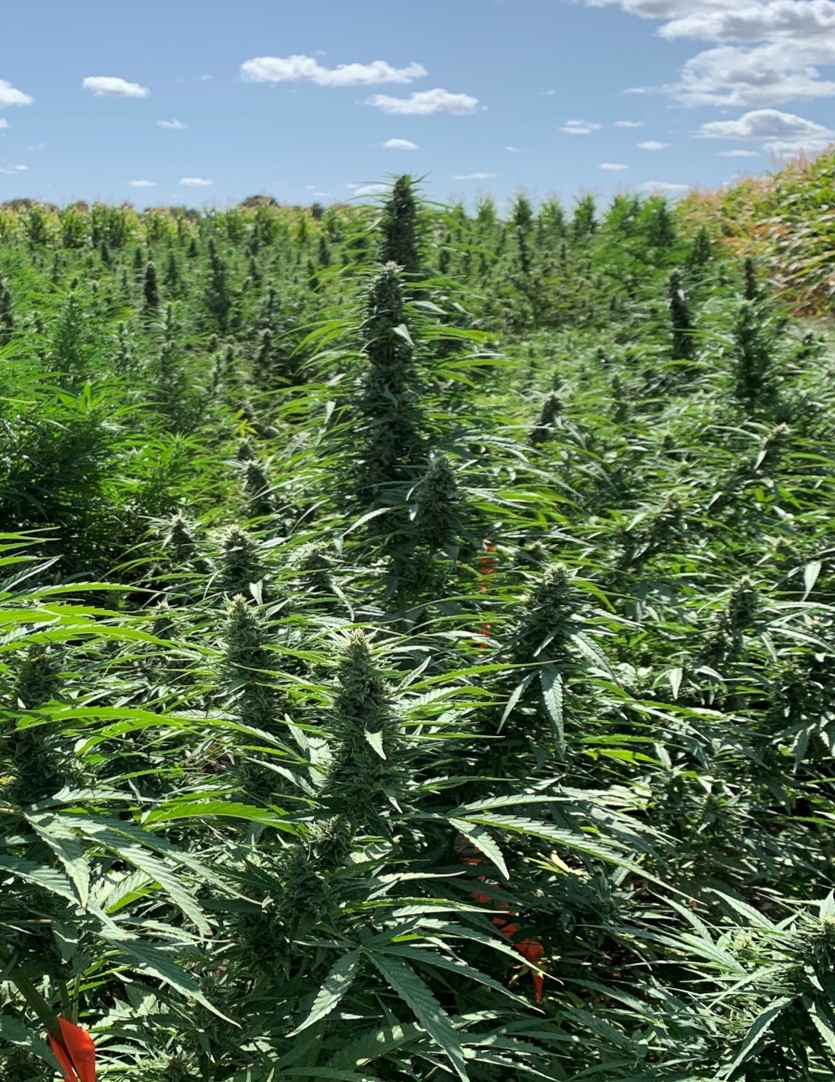![1-1-1 IMG_2273_Full-Season-trial_WestSideREC_9_21[382] by Bob Hutmacher UC Davis](https://organicfarmermag.com/wp-content/uploads/2021/10/1-1-1-IMG_2273_Full-Season-trial_WestSideREC_9_21382-by-Bob-Hutmacher-UC-Davis-1-rotated-1.jpg)
With industrial hemp becoming a crop option in California, there is still much to learn about growing it. For instance, how much nitrogen do hemp plants need for optimal growth and optimal production of essential oils such as CBD? And how much nitrogen is too much, possibly causing harm to the environment?
Researchers at UC Davis and at the UC ANR West Side Research and Extension Center (WSREC) are taking a closer look at this nitrogen balancing act. The research team, headed by UCCE specialists Bob Hutmacher and Dan Putnam, has launched a hemp nitrogen fertilizer project this year. UC colleagues involved in the studies include Sarah Light, Geoffrey Koch, Daniel Geisseler, Nicholas Clark, Maya Hotz and Jorge Angeles. Although these UC researchers have been doing hemp irrigation trials for multiple years, this is the first trial specifically for assessing plant responses to nitrogen levels. The nitrogen management trial will continue for three years.
Fertilizer, Yield and CBD
“Part of what we’re attempting to do is come up with basic information on impacts of applied nitrogen fertilizer levels on cola (bud cluster) yields and production of CBD and essential oils in our region,” said Hutmacher, director of UC’s West Side Research and Extension Center. “Part of the work is to look at crop efficiency in nitrogen use.”
Josh Schneider, CEO of Cultivaris Hemp, said, “The most important aspect of the study is looking at the link between nitrogen levels and cannabinoid (CBD).”
Cultivaris Hemp donated transplants used in evaluating responses of full-season types of cultivars. They are one of four companies donating goods or services to the hemp nitrogen project.
Schneider said when hemp was legalized in the 2018 farm bill it caught states such as California flat-footed. While California, along with most other states, was scrambling to catch up, the “green rush” was on.
“Farmers were already ordering seeds and plants. But most didn’t have the know-how or the research behind the crop. The number of people who understood it well were limited. There wasn’t a lot of hard agronomic information for growers,” Schneider said. “That’s why there’s not much of this research that has been done, and why we have to do more of it.”
Christopher E. Hohm, Ph.D., agrees that the nitrogen project is important. Hohn is the Director of Research and Development at Kayagene, LLC. Kayagene donated hemp seed of one of their varieties to the project.
“Research, like that which is being done at UC Davis, will help farmers make essential decisions about best practices for growing hemp and help advance the hemp industry as a whole. The more knowledge that a farmer has at their disposal, the more likely they are to be successful,” Hohn said.
“Universities like UC Davis are an essential component to bringing reliable data and science-based information to farmers,” he continued. “As a part of the industry, Kayagene believes it is also the responsibility of private companies to support this type of research to do our part in contributing to the community.”

Double Test Plots
The trials are being run as four different tests in two separate field trial locations; one at UC Davis and one at the WSREC located in Fresno County on the westside of the San Joaquin Valley. At both locations, researchers planted two nitrogen trials of approximately 0.75 acres each, one planted to shorter growing season, smaller “auto flower” varieties, and the other planted to longer growing season, larger “full-season” varieties.
“We decided to set up the auto-flower versus full-season field trials as fully separate trials based on differences in photoperiod responses, and large differences in size of plants and time to maturity,” Hutmacher said.
Auto flowering varieties, Cannabis ruderalis, don’t require a specific photoperiod of light to dark ratio hours. They automatically begin to flower without regard to light cycle changes. Full-term (full-season) varieties, Cannabis indica and Cannabis sativa, switch to flowering stage after the light cycle they receive drops below a certain duration of daylight. In the central California region, that would typically occur mid-summer.
“In each of the nitrogen experiments, there are five different treatment levels,” Hutmacher said. “The peak amount we are applying in the auto flower cultivar treatments is about half the nitrogen applied in the full-season plants.”
At the starting point of the study, researchers applied base applications of phosphorus and potassium. The range of treatment fertilizer N applications goes from about 0 to 120 pounds of nitrogen fertilizer per acre with the auto flower cultivars, versus 0 to 220 pounds of nitrogen per acre for full-season cultivars.
“Typically, in such a study, we are looking for where there is optimal response in terms of high yields combined with acceptable concentrations of essential oils,” Hutmacher said. “You don’t want to over-apply. We’re looking for the plants’ best yield and best quality. For example, perhaps the best response for auto flower cultivars might peak out at 90 pounds N per acre rather than at 120 pounds per acre.”
Spoon Feed Nitrogen
Hutmacher said the study is similar to what people have tried to do with most crops under the nitrogen management plan restrictions of California. “We’re looking for acceptable yield with acceptable quality.”
As for irrigating the trial plots, “We made a choice in managing all these trials to use drip irrigation. The reason is we pretty much figured with these higher-value crops, there is a higher level of probability that you would use a tighter control of water and fertilizer,” Hutmacher said.
“One of the options for improved nitrogen can be to actually spoon-feed plants in small doses over the course of the season, so you’re not putting on any massive applications at any time,” Hutmacher said. “Using subsurface drip puts out small amounts at a time [when fertigating]. If you’re careful, you can exert a high level of control over where applied water and fertilizer is distributed, making sure more stays within reach of the root system.”
Subsurface drip irrigation is a low-pressure but efficient irrigation system. Using buried drip tape or drip tubes, it can save water and improve yields while still meeting crop water needs, according to Colorado State Extension.
What about Organic Practices?
Although this study is not focused on organic nitrogen sources, such as fish emulsion, organic growers can still gain insight from the trials.
Are there UC Davis organic hemp nutrition trials in the future?
“Yeah, I think so, if the market starts pointing towards more organic product, that is something that might be researched later,” Hutmacher said, adding that from a pest management standpoint, availability of synthetic pesticide materials for industrial hemp is currently near non-existent levels for California producers.
“Future decisions on which markets intend to use the harvestable products will have a strong influence on choice of organic production versus production involving synthetic chemicals,” Hutmacher said.
Hutmacher pointed out that with hemp, growers have a lot of different options as far as types and uses. To use nitrogen fertilizer efficiently, the type of hemp a grower produces comes into play.
“If you’re producing a crop solely for biomass, such as for fiber or even grain/seed production, the optimal amount of fertilizer N needed would likely differ considerably from what might be optimal for essential oil production,” Hutmacher said. “For this particular study, we’re not looking at grain and fiber plant types.”
How long will it be until growers can access information gathered from the trials?
“We’ll have some data out next year, but more complete information will start coming after the 2022 growing season,” Hutmacher said.
The three-year nitrogen management trial is supported by the California Department of Food and Agriculture Fertilizer Research Education Program (CDFA-FREP). Besides Cultivaris Hemp of Encinitas, Calif. and Kayagene, LLC of Hollister, Calif., Phylos Biosciences of Portland, Ore. also donated seeds, starts or cuttings (clones). The project will also include THC and CBD analysis. Alkemist Labs of Garden Grove, Calif. is donating its crop sample analyzing services.
“These are incredibly valuable donations to assist with this project, certainly in excess of $50,000 in donated materials and services from each of those companies,” Hutmacher said. “We wouldn’t be able to do the study without the help. The donations have been super important, and the industry people have just been so full of information.”






